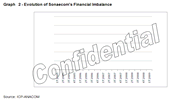In the first market analysis, ICP-ANACOM identified a market failure called ''price discrimination as a strategy for closing the market (foreclosure)''. This competition problem involves the larger operators charging on-net retail prices which are much lower than the retail off-net prices, associated with termination rates which are excessively above cost, thereby amplifying the network effects.
This is a practice that places the smallest operator in a situation of clear competitive disadvantage when it comes to the acquisition and retention of customers, with greater impact in mature markets, where relevant increases in market share are essentially associated with the change of operator.
ICP-ANACOM, both with the publication of the Draft Decision, and with the publication of the Final Decision of 2008, alerted the two largest mobile operators as to the importance of reducing the on-net and off-net price differential in their tariffs. As shown above, the behaviour of these operators in terms of introducing new tariffs was not conducive to reducing this gap which instead was increased.
In the Market Analysis, published simultaneously with this decision, ICP-ANACOM shows that there remains a high level of differentiation in terms of revenue per minute between on-net and off-net calls 1 (although this has been lower than in the past 2).
The imbalance in the termination payments made by Sonaecom to other operators declined significantly after the 2008 Price Control Decision, as was to be expected, despite the high values of imbalance recorded by Sonaecom, due to lower termination rates and the transitory asymmetry applied in the last two quarters of 2008 and the first three quarters of 2009. Graph 2 gives a view of the reduction of the imbalance up to the end of the first quarter of 2009.
(SCI)
Graph 2 - Evolution of Sonaecom's Financial Imbalance
(ECI)
The analysis performed here of the competition problem identified in 2005 and 2008, in terms of traffic imbalance and the tariff differentiation between on net and off-net calls leads to the conclusion that these factors remain applicable today. Another conclusion that is drawn from this analysis is that ICP-ANACOM's intervention in July 2008 to reduce termination rates from 11 cents per minute to 6.5 cents per minute (associated with a limited and transitory asymmetry) had the desired effects in terms of increased competitiveness and benefits for the end-consumers, in terms of mobile-mobile traffic. Since the structural problem previously identified remained evident, there remained a need for a sharp reduction in mobile termination rates in order to further and effectively combat this problem.
Since the analysis performed by ICP-ANACOM with respect to international developments, at the ERG and the European Commission, described in the previous section, also the analysis of the behaviour of operators in the retail market, and the European benchmarking of termination rates examined in section 5, point to the need for further reductions in mobile termination rates during the next period of application of price control.
1 In this regard reference is made to graphs 10 and 11 of the Market Analysis Decision.
2 Since for this purpose of reducing the level of differential, in terms of the revenue per minute, there will have been some impact resulting from the evolution of consumer traffic profiles, particularly switching to new tariffs with less reduced off-net prices (for example low cost tariffs), and less impact from changes promoted by the larger operators. In addition, it is noted that if the value of the elasticity of demand for minutes off-net of customers who subscribe to different tariff were sufficiently high, a higher degree of differentiation (i.e. the relative off-net /on-net price increase) of this type of tariff could lead to a reduction in the average off-net revenue per minute of a given operator.





